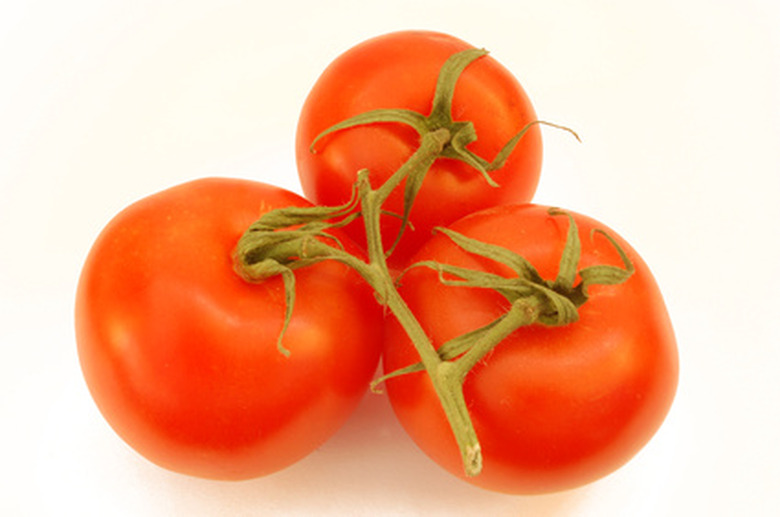What Nutrients Does Soil Need For Tomatoes To Grow?
Tomatoes can be picky vegetables for the home gardener. Sometimes lush, green plants blossom but do not set fruit, and some plants do not even blossom before the cold weather starts. Tomatoes are heavy feeders that need a rich, well-drained soil. The plants usually benefit from extra fertilizer applications during each growth stage. Synthetic chemicals feed tomato plants, but feeding the soil with the right nutrients is healthier for the tomatoes and you.
Nitrogen
To get a good start, tomatoes need lots of nitrogen. Nitrogen promotes strong leaf growth which the plants need to photosynthesize light into sugar and feed the developing flowers and fruits. Liquid fish emulsion is high in nitrogen, and seed meals (like cottonseed, rapeseed or alfalfa meal) contain small amounts of phosphorus and potassium, which are also required. Water seedlings with diluted fish emulsion every two weeks after the first true leaves have appeared, or mix a small amount of seed meal into the soil around the base of the plant, where watering will take the nutrients down to the roots.
- Tomatoes can be picky vegetables for the home gardener.
- Water seedlings with diluted fish emulsion every two weeks after the first true leaves have appeared, or mix a small amount of seed meal into the soil around the base of the plant, where watering will take the nutrients down to the roots.
Phosphorus
Plants require phosphorus to aid the photosynthesis process and stimulate blooming. Tomatoes benefit from the addition of phosphorus when planting established seedlings out into the garden. Bone meal, bat and bird guano, and rock phosphate are all good sources of phosphorus. Bone meal and guano release to the plant quickly, while rock phosphate is slower but has the advantage of enriching the soil more over time. When transplanting, add bone meal, guano or rock phosphate into the planting hole, and spread one of these fertilizers around the base of the plant at least once before it starts blooming.
Potassium
Potassium is necessary for the flower and fruit development of a tomato plant, and plants with potassium deficiencies will have few fruits, if any. Kelp meal is an excellent source of potassium, as is Jersey greensand (a rock dust). Add potassium fertilizer to the soil around the plant after it has been in the ground for a couple of weeks and again when it blooms.
- Plants require phosphorus to aid the photosynthesis process and stimulate blooming.
- Bone meal and guano release to the plant quickly, while rock phosphate is slower but has the advantage of enriching the soil more over time.
Trace Minerals and Micronutrients
In addition to nitrogen, phosphorus and potassium, tomato plants require throughout their development trace nutrients like calcium and magnesium, as well as micronutrients like zinc, manganese and copper. Dolomite lime is a rich source of calcium and magnesium, as well as iron and sulfur. It also helps offset the acidity of seed meals and maintain the neutral pH tomatoes require. It should be mixed into the soil prior to planting. Kelp meal also has a nice balance of necessary micronutrients.
Tomato plants benefit from additions of aged compost and aged manure at least once or twice as they're growing. These materials add a good balance of nitrogen, potassium and phosphorus as well as the trace and micronutrients, and they improve the quality of the soil over time. Spread manure or compost around the base of the plant and water it in. Water and earthworms will take the nutrients down to the plants' roots.
- In addition to nitrogen, phosphorus and potassium, tomato plants require throughout their development trace nutrients like calcium and magnesium, as well as micronutrients like zinc, manganese and copper.
- These materials add a good balance of nitrogen, potassium and phosphorus as well as the trace and micronutrients, and they improve the quality of the soil over time.
